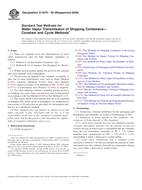We need your consent to use the individual data so that you can see information about your interests, among other things. Click "OK" to give your consent.
ASTM D4279-95(2009)
Standard Test Methods for Water Vapor Transmission of Shipping Containers-Constant and Cycle Methods
STANDARD published on 1.3.2009
The information about the standard:
Designation standards: ASTM D4279-95(2009)
Note: WITHDRAWN
Publication date standards: 1.3.2009
SKU: NS-26654
The number of pages: 4
Approximate weight : 12 g (0.03 lbs)
Country: American technical standard
Category: Technical standards ASTM
The category - similar standards:
Annotation of standard text ASTM D4279-95(2009) :
Keywords:
constant rate of gain, cycle method, desiccant, reclosable containers, water vapor permeability, Constant/cycle methods, Linerboard, Reclosable containers, Shipping containers/materials/applications, Water vapor transmission (WVT), ICS Number Code 55.040 (Packaging materials and accessories)
Additional information
| Significance and Use | ||||||||||||||||||||
|
These test methods are normally used for the following purposes: To evaluate materials and constructions for a specific type of container, To compare performance of different types of containers, To determine adequacy of protection for a specific product or application, and To maintain quality control. |
||||||||||||||||||||
| 1. Scope | ||||||||||||||||||||
|
1.1 These test methods cover the determination of water vapor transmission rates for bulk shipping containers, as follows: 1.1.1 Method A, for Reclosable Containers, and 1.1.2 Method B, for Containers Not Designed for Reclosing. 1.2 Within each procedure details are given for the constant and cycle methods of test atmosphere. 1.3 The test may be applied to the container as packed, or after one or more performance tests such as drum (Method D 782), vibration (Methods D 999), drop (Test Method D 5276), impact resistance (Test Methods D 880, D 4003, and D 5277), or performance tests (Practice D 4169), as required. 1.4 For small shipping containers requiring greater accuracy in weighing, the water vapor transmission may be determined in accordance with Test Method D 895 or Test Method D 1251. 1.5 The values stated in inch-pound units are to be regarded as standard. The values given in parentheses are mathematical conversions to SI units that are provided for information only and are not considered standard. 1.6 This standard does not purport to address all of the safety concerns, if any, associated with its use. It is the responsibility of the user of this standard to establish appropriate safety and health practices and determine the applicability of regulatory limitations prior to use. |
||||||||||||||||||||
| 2. Referenced Documents | ||||||||||||||||||||
|
We recommend:
Technical standards updating
Do you want to make sure you use only the valid technical standards?
We can offer you a solution which will provide you a monthly overview concerning the updating of standards which you use.
Would you like to know more? Look at this page.




 Cookies
Cookies
